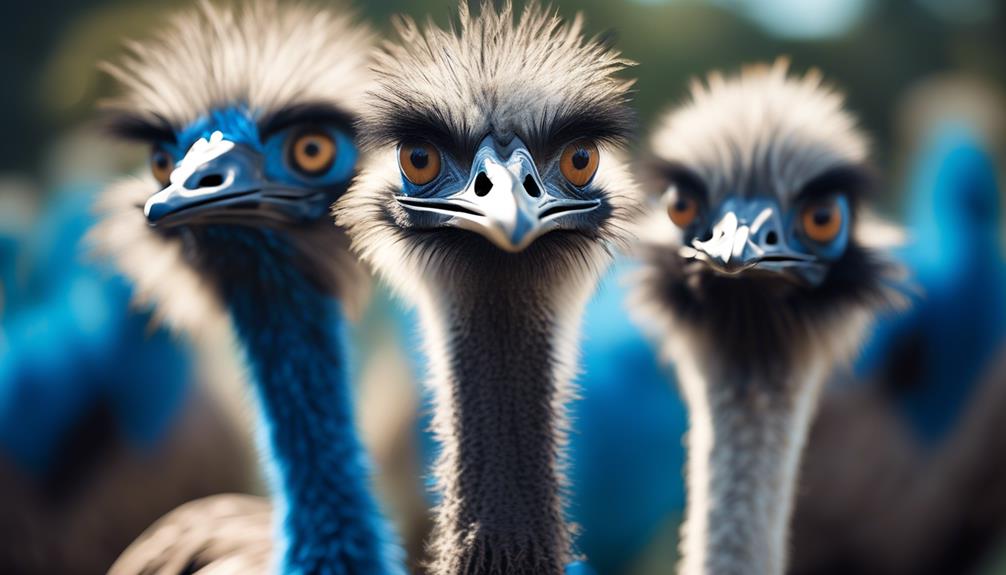
They say 'birds of a feather flock together,' but when it comes to emus and ostriches, it's the differences that set them apart.
These two flightless birds may seem similar at first glance, but upon closer inspection, their unique characteristics become apparent. From their physical appearance to their behaviors and habitats, understanding the disparities between emus and ostriches can provide fascinating insights into the world of avian diversity.
So, let's dive into the captivating realm of these magnificent creatures and uncover the intriguing contrasts that make them truly remarkable.
Key Takeaways
- Emus and ostriches differ in size, with emus being smaller and lighter than ostriches.
- Emus have predominantly brown plumage while ostriches have black feathers, with females having a mix of black and brown.
- The beak and head shape of emus and ostriches are different, with emus having a long, slender beak curved downward, and ostriches having a short, broad beak.
- Emus and ostriches have similar adaptations for speed and survival, such as long, powerful legs, strong tendons and cushioned pads in their feet, exceptional eyesight, and strong, muscular bodies.
Physical Appearance
When comparing the physical appearances of emus and ostriches, several distinct differences can be observed.
Emus are slightly smaller than ostriches, with an average height of around 5 to 6 feet and a weight ranging from 80 to 130 pounds. Ostriches, on the other hand, are the largest birds in the world, standing at an impressive height of 7 to 9 feet and weighing between 200 and 300 pounds. The plumage of emus is predominantly brown, while ostriches have black feathers.
Another noticeable distinction can be seen in their necks. Emus possess a shorter neck that curves gracefully, whereas the neck of an ostrich is longer and straight. This difference in neck structure directly influences their mating rituals.
During courtship, male emus engage in a complex dance, fluffing their feathers and emitting deep, resonating drum-like sounds. In contrast, male ostriches perform an elaborate mating dance, spreading their wings and swaying their necks while emitting low-frequency booming vocalizations.
Size and Weight
Emus and ostriches differ significantly in terms of their size and weight, with emus being smaller and lighter than ostriches. Let's take a closer look at the size comparisons and weight differences between these two fascinating birds.
When it comes to size, emus stand at an average height of around 5 to 6.2 feet (1.5 to 1.9 meters) tall, making them considerably shorter than ostriches. In contrast, ostriches can reach towering heights of up to 8.2 feet (2.5 meters). This significant difference in height is due to the varying evolutionary adaptations of these birds.
In addition to their height disparity, emus also weigh less than ostriches. On average, adult emus weigh between 88 to 132 pounds (40 to 60 kilograms). In comparison, adult ostriches can weigh anywhere between 220 to 330 pounds (100 to 150 kilograms). This weight difference can be attributed to the fact that ostriches are the largest and heaviest birds in the world.
Understanding the size comparison and weight differences between emus and ostriches provides insight into the unique characteristics of these two species. While emus are smaller and lighter, ostriches stand as the giants of the avian world.
Feather Coloration
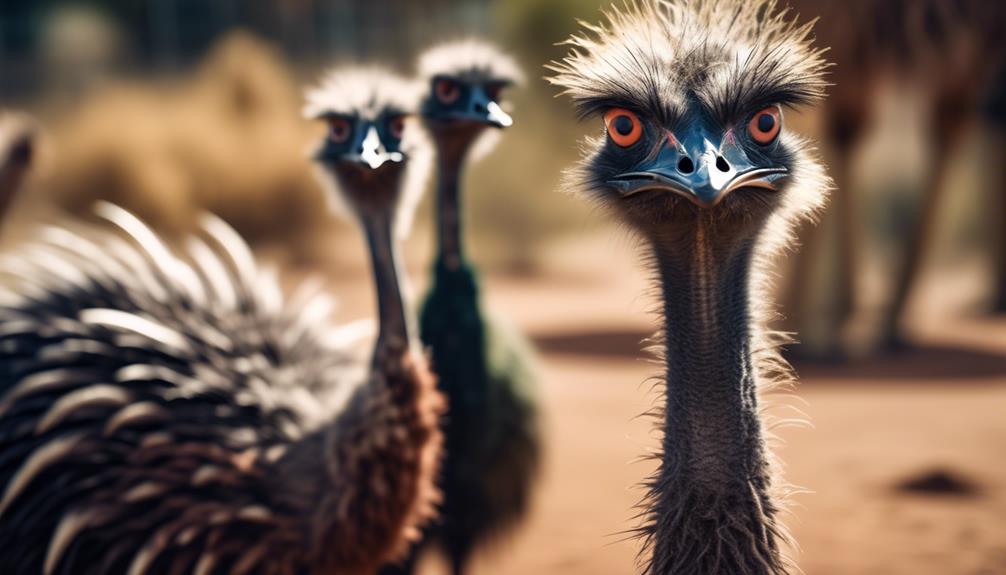
Moving on from discussing the size and weight differences between emus and ostriches, let's now explore the intriguing topic of feather coloration in these remarkable avian species. Feather coloration plays a crucial role in the mating rituals and camouflage strategies of both emus and ostriches.
Emus, with their gray-brown feathers, exhibit a cryptic coloration that allows them to blend seamlessly with their surroundings. This coloration serves as an effective camouflage strategy, enabling them to evade predators and approach their prey unnoticed. Furthermore, during the mating season, male emus develop darker feathers on their head and neck, accentuating their features and signaling their readiness to mate.
In contrast, ostriches display a strikingly different feather coloration. The males boast predominantly black feathers, while the females flaunt a mix of black and brown. This sexual dimorphism is believed to aid in courtship displays, as the male's contrasting feathers attract the attention of potential mates. Moreover, ostriches possess specialized feathers on their wings and tail that, when extended, create an impressive display of white plumage. This elaborate feather arrangement serves as a visual cue during courtship, indicating the male's fitness and ability to provide for offspring.
Beak and Head Shape
The beak and head shape of emus and ostriches exhibit notable differences in structure and function. These differences play a crucial role in their respective feeding strategies and overall survival in their natural habitats. Here are four key distinctions to consider:
- Beak structure: Emus possess a long, slender beak that's slightly curved downward. This design allows them to effectively grasp and pluck foliage from trees and shrubs. On the other hand, ostriches have a short, broad beak that's more suited for grazing on the ground.
- Head size: Emus have relatively smaller heads compared to their ostrich counterparts. This adaptation allows them to maneuver more easily through dense vegetation and navigate their surroundings more efficiently. Ostriches, with their larger heads, have an advantage in detecting potential threats and predators from a greater distance.
- Functionality: Emus primarily use their beaks for foraging, probing the ground for insects, seeds, and small animals. In contrast, ostriches utilize their beaks for grazing on grasses and other low-lying vegetation. Their beaks are less flexible, but highly effective in cutting and tearing plant material.
- Sensory adaptations: Both emus and ostriches have well-developed eyesight, but emus also possess a keen sense of smell. This allows emus to detect food sources and potential predators more readily, even in low-light conditions.
Understanding these differences in beak structure and head size provides insight into the distinct ecological niches occupied by emus and ostriches. Their unique adaptations enable each species to thrive in their respective environments, showcasing the fascinating diversity within the avian world.
Adaptations for Speed and Survival
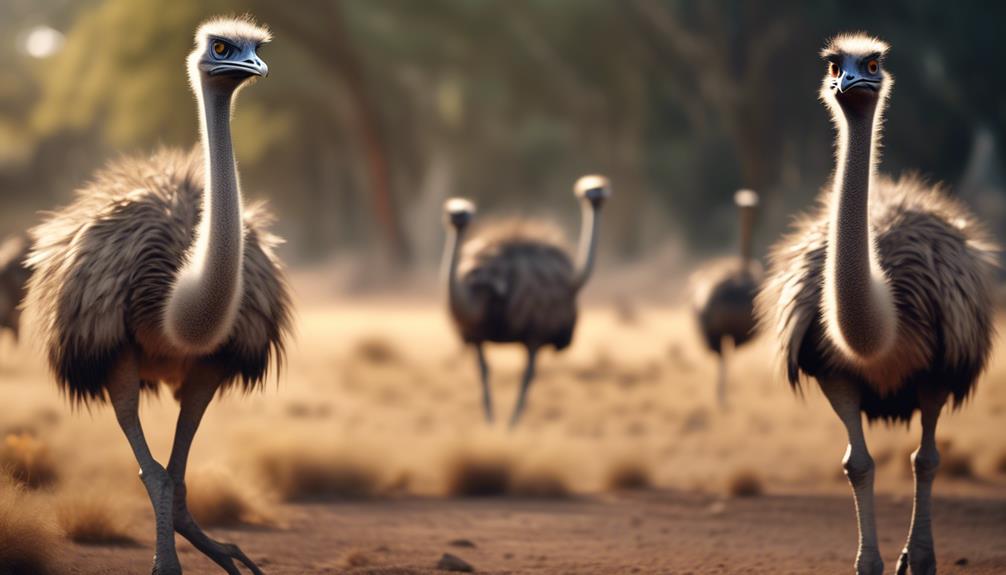
To ensure their survival and thrive in their natural habitats, both emus and ostriches have developed remarkable adaptations for speed and survival. These adaptations primarily revolve around their ability to run and evade predators.
Both emus and ostriches have long, powerful legs that enable them to achieve incredible speeds while running. Their leg muscles are well-developed and designed for endurance, allowing them to maintain their speed over long distances. Additionally, their feet are uniquely adapted to absorb the impact of running, with strong, flexible tendons and cushioned pads that provide shock absorption and enhance their stability while in motion.
In terms of predator evasion, both species have evolved strategies to outsmart their pursuers. When threatened, emus and ostriches rely on their exceptional eyesight to detect potential danger from a distance. Their large eyes are positioned on the sides of their heads, giving them a wide field of vision. This allows them to spot predators approaching from different angles, giving them ample time to react and flee.
Furthermore, both emus and ostriches possess strong, muscular bodies that enable them to change direction quickly and maneuver through their environment with agility. This agility, combined with their impressive running speed, makes it difficult for predators to catch them.
Behavioral Differences
As we shift our focus to the behavioral differences between emus and ostriches, it's important to explore how their distinct adaptations for speed and survival influence their actions and interactions within their respective environments.
- Social interactions:
Emus are known to be more social than ostriches. They form small groups and engage in activities such as preening each other's feathers and vocalizing to communicate. Ostriches, on the other hand, are more solitary creatures and prefer to spend their time alone or in pairs.
- Feeding habits:
Emus have a more varied diet compared to ostriches. They're opportunistic feeders and consume a wide range of plant matter, insects, and small vertebrates. Ostriches primarily feed on grasses and seeds, and occasionally insects and small animals.
- Nesting behavior:
Emus build their nests on the ground, using vegetation as a form of camouflage. They take turns incubating the eggs and raising the chicks. Ostriches, on the other hand, build their nests in a shallow depression in the ground and the male takes the responsibility of incubation.
- Aggression:
Emus are generally more aggressive than ostriches. They've been known to charge and kick when they feel threatened. Ostriches, although capable of defending themselves, are generally more docile and prefer to flee rather than fight.
Understanding these behavioral differences between emus and ostriches provides valuable insights into their respective lifestyles and survival strategies.
Habitat and Distribution
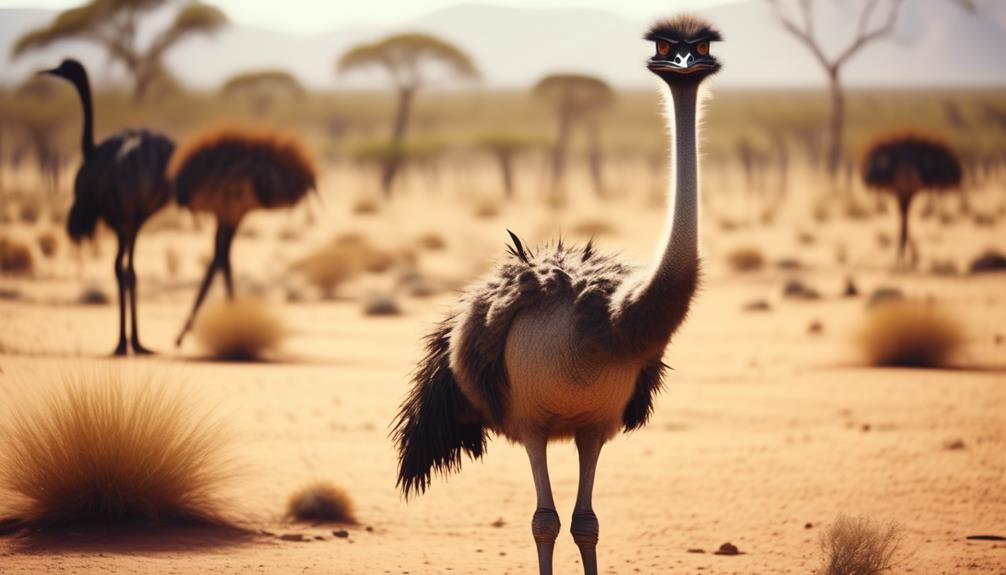
Emus and ostriches inhabit distinct habitats and have different distributions, reflecting their adaptive strategies for survival in their respective environments. Habitat preferences play a crucial role in determining the geographic range of these flightless birds.
Emus are native to Australia, where they're found in a variety of habitats, including grasslands, woodlands, and open forests. They've a wide distribution across the continent, ranging from coastal areas to arid regions. Emus are well-adapted to the harsh Australian climate, with their long legs and ability to withstand extreme temperatures. They prefer areas with access to water sources, as they require regular drinking and bathing.
On the other hand, ostriches are native to Africa and are primarily found in grasslands, savannas, and semi-desert regions. They've a more limited geographic range compared to emus, being concentrated in specific areas of the continent. Ostriches are highly adaptable and can survive in diverse habitats, including arid and desert regions. They're well-known for their ability to withstand high temperatures and can go without water for extended periods.
Reproduction and Parental Care
Moving on to the topic of reproduction and parental care, it's essential to understand how emus and ostriches differ in their reproductive strategies and the level of care they provide to their offspring.
Courtship behavior: Both emus and ostriches engage in elaborate courtship displays to attract mates. These displays involve dancing, vocalizations, and feather displays. Witnessing these courtship rituals can be a truly captivating experience, as the birds showcase their beauty and agility in an attempt to win over their potential partners.
Egg incubation: Emus and ostriches have different approaches when it comes to incubating their eggs. Female emus take charge of the entire incubation process, building a nest and laying their eggs. The male emu then takes over the responsibility of incubating the eggs for a duration of approximately 56 days.
On the other hand, ostriches have a communal nesting system, where multiple females lay their eggs in a single nest. The dominant female and male then take turns incubating the eggs, providing warmth and protection.
Understanding the differences in courtship behavior and egg incubation between emus and ostriches adds depth to our knowledge of these incredible birds' reproductive strategies. Their unique approaches to reproduction and parental care highlight the diversity that exists in the animal kingdom, captivating our hearts and minds.
Conservation Status and Threats
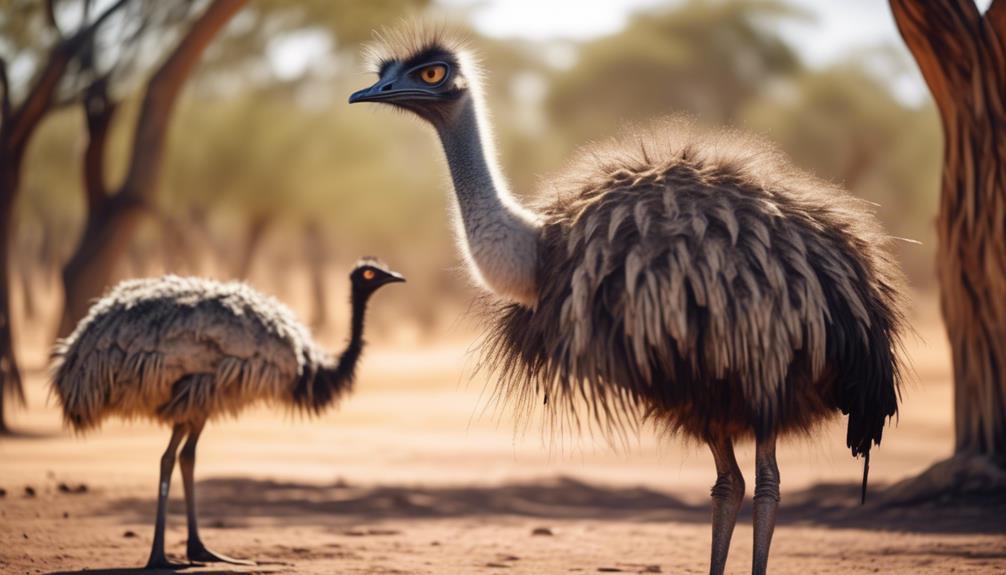
The conservation status and threats faced by emus and ostriches are crucial aspects to consider in understanding the challenges these remarkable birds encounter in their natural habitats. Conservation efforts play a vital role in safeguarding these species, as both emus and ostriches face various threats due to human impact.
Emus, native to Australia, are classified as a species of 'Least Concern' by the International Union for Conservation of Nature (IUCN). This status reflects their relatively stable population and widespread distribution. However, they still face several threats. Habitat loss due to land clearing for agriculture and urbanization is a significant concern. Emus also face risks from predation, road accidents, and hunting.
Ostriches, found in Africa, are listed as 'Vulnerable' by the IUCN. They've experienced a significant decline in population due to habitat degradation and loss caused by human activities. Additionally, ostriches are hunted for their feathers, eggs, and meat. Climate change and overgrazing by domestic livestock further exacerbate the threats faced by ostriches.
Conservation efforts for both species focus on protecting their habitats, implementing sustainable land-use practices, and raising awareness about the importance of these species in their ecosystems. Collaborative initiatives between governments, conservation organizations, and local communities are crucial to ensure the long-term survival of emus and ostriches in the face of human impact.
Frequently Asked Questions
Are Emus and Ostriches Related to Each Other?
Emus and ostriches, are they related to each other? Well, the answer lies in their common ancestor or independent evolution. By examining their genetic similarities, we can uncover the truth.
What Is the Lifespan of Emus and Ostriches?
On average, emus and ostriches have lifespans influenced by various factors. These include genetics, diet, habitat, and overall health. Understanding these factors is key to appreciating the differences in their average lifespans.
How Fast Can Emus and Ostriches Run?
Emus and ostriches, two flightless birds, are renowned for their extraordinary running speed. Their powerful, muscular legs and unique leg structure enable them to sprint at impressive velocities, contributing to their survival in their respective habitats.
Can Emus and Ostriches Fly?
You might be surprised, but emus and ostriches, despite their large size, cannot fly. They lack the necessary wings to take flight. Instead, they have adapted to run at incredible speeds on land.
Do Emus and Ostriches Have Any Natural Predators?
Emus and ostriches have natural predators due to their hunting habits and adaptations for survival. Understanding these predators is crucial for the survival of both species.
Conclusion
In conclusion, while emus and ostriches may appear similar at first glance, there are several key differences that distinguish these flightless birds.
Emus are generally smaller and lighter than ostriches, with distinctive brown feather coloration and a rounded beak. Ostriches, on the other hand, are larger and heavier, with black and white feathers and a distinctively long and flat beak.
One interesting statistic to note is that emus have a wider range of distribution, inhabiting a variety of habitats across Australia, whereas ostriches are primarily found in Africa.
Understanding these differences can help us appreciate the unique adaptations and behaviors of these remarkable birds.




